Hassani S. Mathematical Physics: A Modern Introduction to Its Foundations
Подождите немного. Документ загружается.

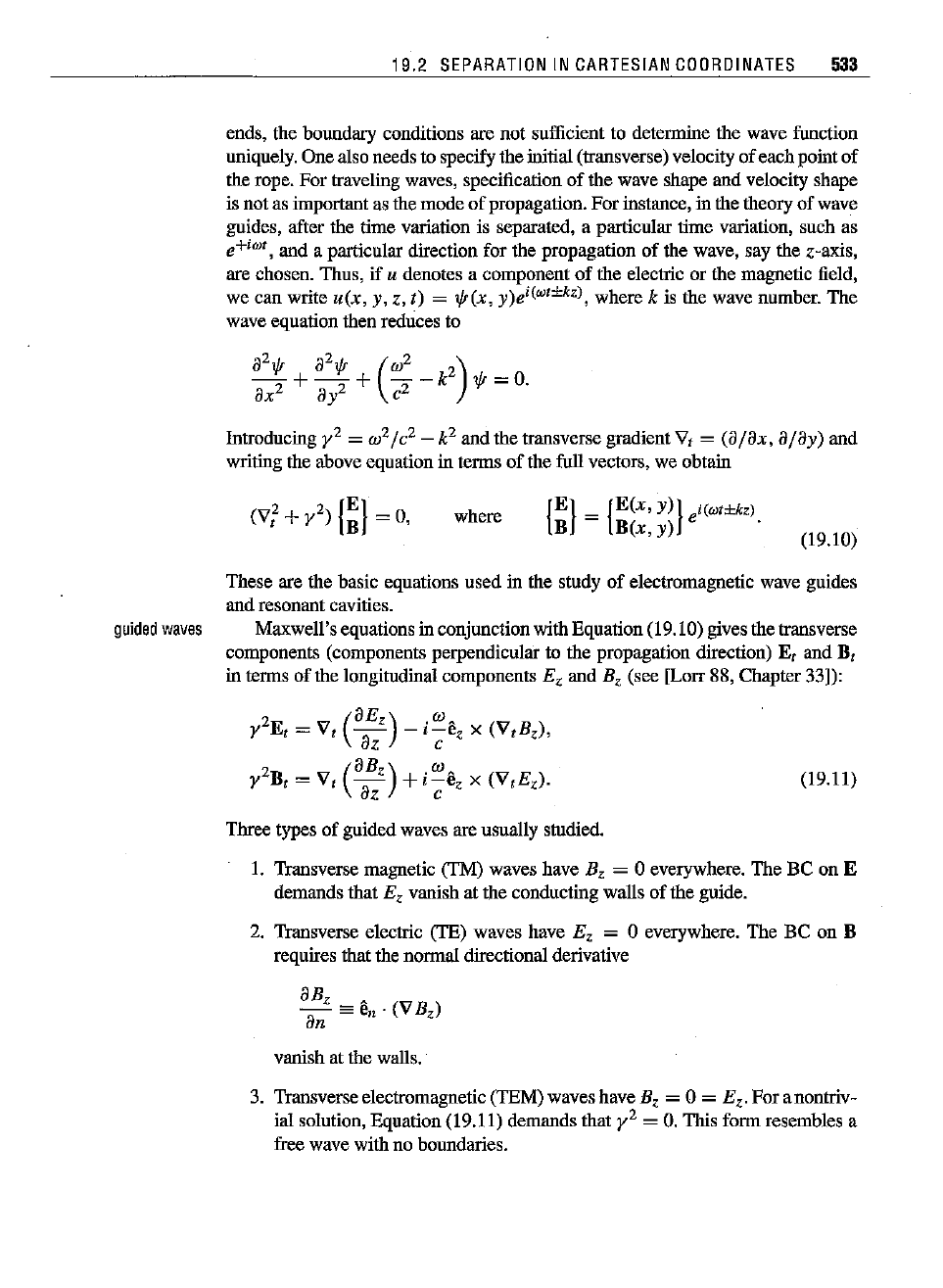
19.2
SEPARATION
IN
CARTESIAN
COOROINATES
533
ends, the boundary conditions are not sufficient to determine the wave function
uniquely. One also needs to specify the initial (transverse) velocity
of
eachpoint
of
the rope.
For
traveling waves, specification
of
the wave shape and velocity shape
is not as important as the mode
of
propagation.
For
instance, in the theory
of
wave
guides, after the time variation is separated, a particular time variation, such as
e+
iwt
, anda
particular
direction
for the
propagation
of the wave, say thez-axis,
are chosen. Thus,
if
u denotes a component
of
the electric or the magnetic field,
we can write
u(x,
y,
Z, z) = 1fr(x, y)e'(WI±k'l, where k is the wave number.
The
wave
equation
then
reduces
to
Introducing y2 = w
2
/c
2
-
k
2
and the transverse gradient V, =
(a/ax,
a/ay)
and
writing the above equation in terms
of
the full vectors, we obtain
2 2
{E}
(V, +Y ) B = 0,
where
{
E}
=
{E(x,
y)}
e,(wIHz)
B
B(x,
y)
(19.10)
These are the basic equations used in the study
of
electromagnetic wave guides
and
resonant
cavities.
guided
waves
Maxwell'sequations in conjunctionwith Equation(19.10) gives the transverse
components (components perpendicular to the propagation direction) E
,
and B
,
in terms
of
the longitudinal components E
z
and B
z
(see [Lorr 88, Chapter 33]):
2
(aE
z
)
.W.
y E
,
= V, - -
,-e
z
x
(V,B
z
),
az
c
2
(aB
z
)
.W.
yB,=V
,
-
+,-e,x(V,E
z)'
az
c
Three types
of
guided waves are usually studied.
(19.11)
1. Transverse magnetic
(TM) waves have B, = 0 everywhere. The BC on E
demands that
E
z
vanish at the conducting walls
of
the guide.
2. Transverse electric
(TE) waves have E, = 0 everywhere. The BC on B
requires that the normal directional derivative
vanish at the walls.
3. Transverseelectromagnetic (TEM) waves have
B, = 0 = E
z
.
For anontriv-
ial solution, Equation (19.11) demands that
y2 =
O.
This form resembles a
free wave with no boundaries.
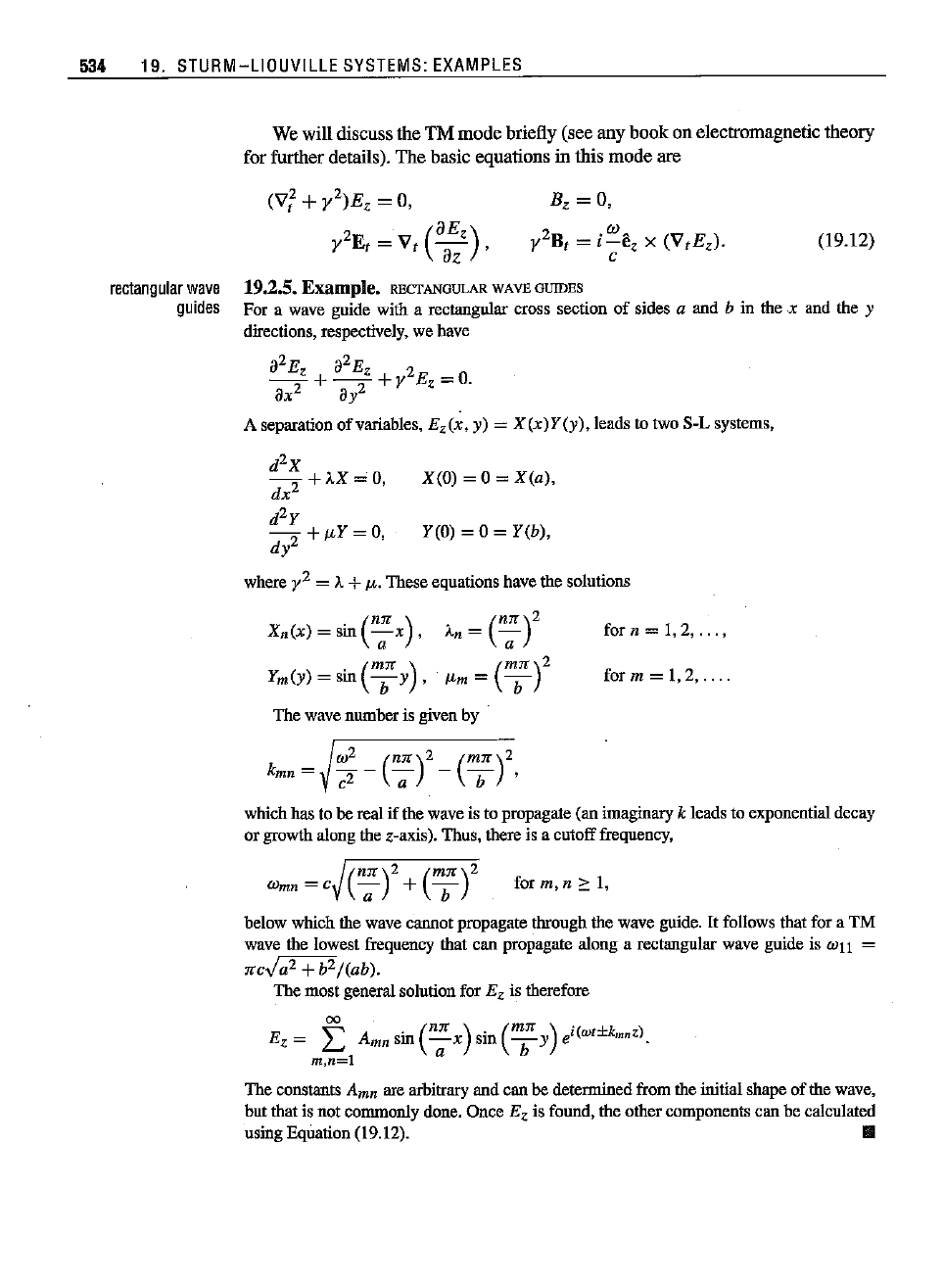
534 19. STURM-LIOUVILLE
SYSTEMS:
EXAMPLES
We willdiscuss the TM
mode
briefly (see any
book
on electromagnetic theory
for further details).
The
basic equations in this mode are
('v;
+YZ)E
z
= 0,
Z
(8E,)
Y E, = V,
az
'
B,
=0,
yZB,
= i
:':e,
x
(V,E,).
c
(19.12)
Y(O) = 0 = Y(b),
X(O) =0 =
X(a),
rectangular
wave
guides
19.2.5.
Example.
REcrANGULAR
WAVE GUIDES
For a wave guide with a
rectangular
cross section of sides a and b in the x and the y
directions,
respectively, wehave
aZE, aZE
z
Z
-z-
+
-z-
+Y E, =
O.
ax
ay
A separationof variables,
E,(x,
y) =
X(x)Y(y),
leads to two SoLsystems,
dZX
-Z
+AX=O,
dx
dZY
-Z
+/LY=O,
dy
where
y2 = A+u: These
equations
havethesolutions
Xn(X) = sin
(n;
x)
,
Ym(y) =
sin
(";,1!'
y)
,
_
(n1!')Z
An -
a
u-m
=
(";,1!')Z
for n = 1,2,
...
,
for m = 1,2,
....
Thewave
number
is givenby
which has tobereal
if
the waveis to
propagate
(an
imaginary
k leadsto
exponential
decay
orgrowthalongthez-axis). Thus,
there
is a cutoff
frequency,
{orm,n
2: 1,
belowwhichthewave
cannot
propagate
through
thewave
guide.
It follows
that
fora TM
wave the lowest
frequency
thatcan
propagate
along a
rectangular
wave guide is WI!
1!'cJ
a
Z
+b
Z
j(ab).
Themost
general
solutionforEz is
therefore
00
E
z
= L
Amnsin(n;
X)
sin
(m
b
1r
y)ei(wt±kmnZ).
m,n=l
The
constants
A
mn
are
arbitrary
andcanbedetermined
from
theinitial shapeof thewave,
butthatisnot
commonly
done.
Once Ez is
found,
theother
components
canbe
calculated
usingEquation(19.12). II
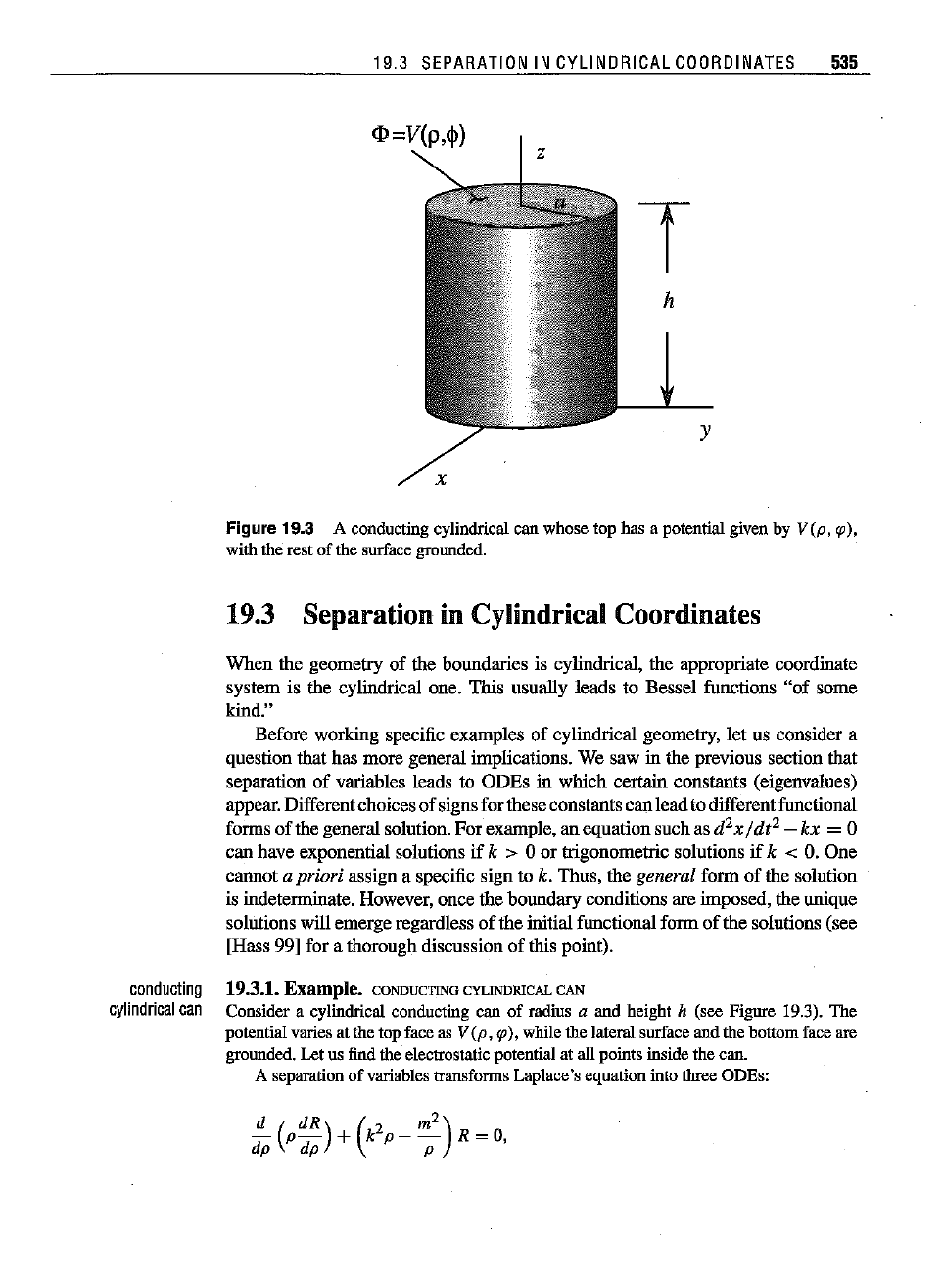
19.3
SEPARATION
IN CYLINDRICAL
COORDINATES
535
«P=V(p,<j»
T
h
y
conducting
cylindrical
can
x
Figure 19.3 A conducting cylindricalcan whosetop has a potentialgivenby
V(p,
\,),
withthe restof thesurface
grounded.
19.3 Separation in Cylindrical Coordinates
When the geometry
of
the boundaries is cylindrical, the appropriate coordinate
system is the cylindrical one. This usually leads to Bessel functions
"of
some
kind."
Before working specific examples
of
cylindrical geometry, let us consider a
question that has more general implications. We saw in the previous section that
separation
of
variables leads to ODEs in which certain constants (eigenvalues)
appear. Differentchoices
of
signs for these constants Canleadto differentfunctional
forms
of
the general solution. For example, an equationsuch as d
2
x/ dt
2
-
kx = 0
can have exponential solutions
if
k > 0
or
trigonometric solutions
if
k <
O.
One
cannot a priori assign a specific sign to k. Thus, the general form
of
the solution
is
indeterminate.
However,
oncethe
boundary
conditions are
imposed,
the
unique
solutions will emerge regardless
of
the initial functional form
of
the solutions (see
[Hass 99] for a thorough discussion
of
this point).
19.3.1.
Example.
CONDUCTING
CYUNDRICAL
CAN
Consider a cylindrical conducting can
of
radius a and height h (see Figure 19.3). The
potential
varies
atthetopfaceasV(p,
<p),
whilethe
lateral
surface
andthe
bottom
face
are
grounded.
Letus
find
the
electrostatic
potential
atallpointsinsidethecan.
A
separation
of
variables transforms
Laplace's
equation
into
three
ODEs:
d
(dR)
(2
m
2
)
-
p-
+ k p - - R = 0,
dp dp p
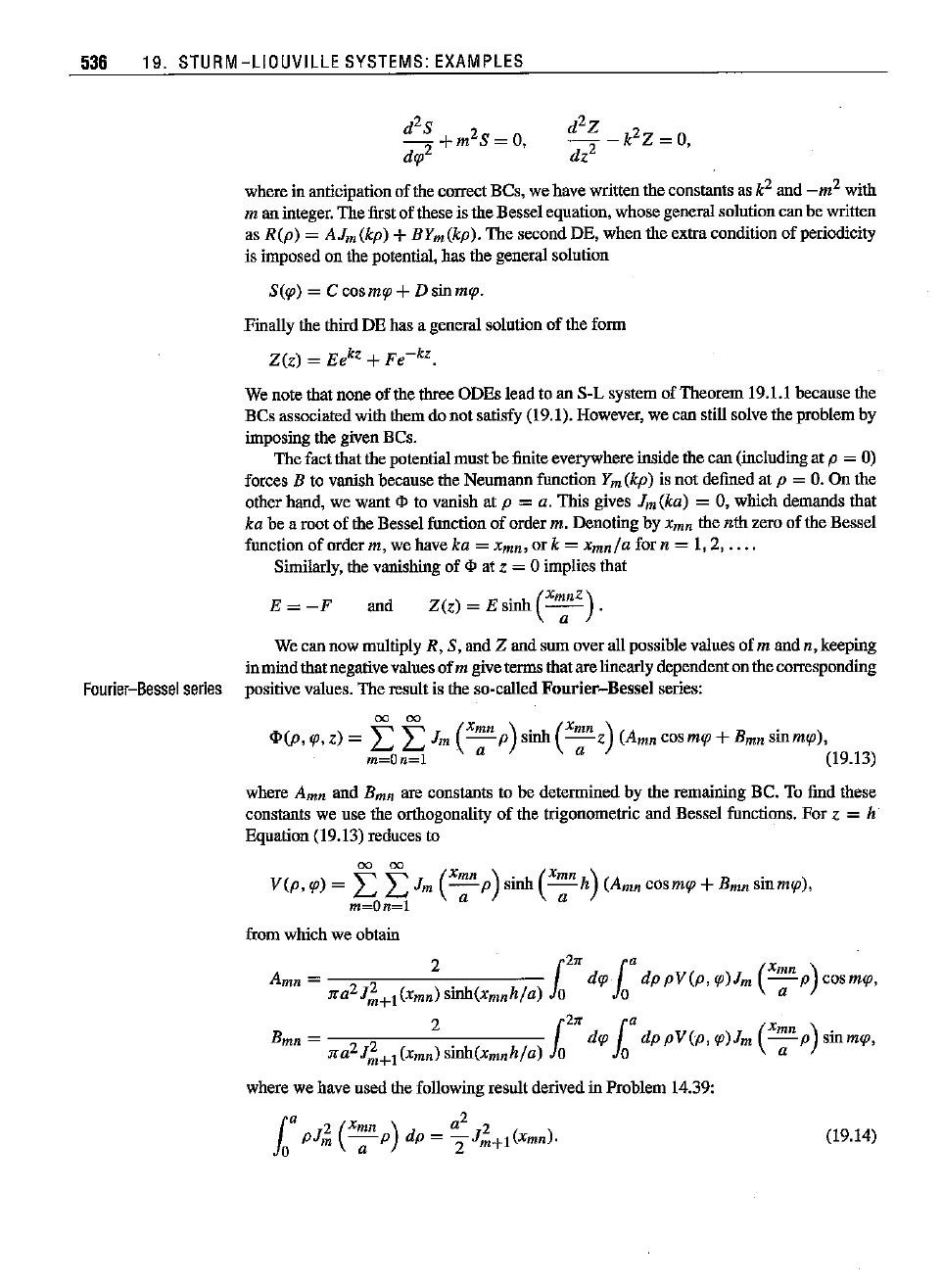
536 19. STURM-LIOUVILLE
SYSTEMS:
EXAMPLES
whereinanticipation of the
correct
Bes, wehave
written
the
constants
ask
2
and_m
2
with
m an
integer.
The
first
of
these
istheBessel
equation,
whose
general
solution
canbe
written
as
R(p)
= AJm(kp) + BYm(kp).
The
second DE,
when
the extra condition
of
periodicity
is
imposed
onthe
potential,
hasthe
general
solution
S(<p)
=
Ccosm<p+
Dsinm<p.
Finally the third DE
hasa general solntion
of
the form
Z(z)
= Ee
kz
+
Fe-
kz
.
and
E=-F
Wenotethatnoneofthe
three
ODEsleadtoanS-L
system
ofTheorem
19.1.1
because
the
Bes
associatedwiththemdo not satisfy (19.1).
However,
we can still solvethe
problem
by
imposing
thegivenBes.
Thefactthatthepotential mustbefiniteeverywhere insidethecan(including atp = 0)
forces
B to
vanish
because
the
Neumann
function
Ym(kp) is not
defined
atp =
O.
On the
other hand, we
want
<I>
to vanish at p = a. This gives Jm(ka) = 0, which demands that
ka be a root
of
the Bessel functionof
order
m. DenotingbyXmn thenthzero
of
the Bessel
function
of
order
m, wehaveka =
Xmn,
ork = xmn/a forn = 1,2,
....
Sintilarly, the vanishing of
<I>
at Z = 0 implies that
.
(xmnz)
Z(z)
= E sinh
-a-
.
Wecan now
multiply
R, S,
and
Z
and
sumoverallpossible
values
ofm
and n, keeping
in
mind
thatnegative
values
ofm give
terms
that
are
linearly
dependent
onthe
corresponding
Fourier-Bessel
series
positive
values.
The
result
istheso-calledFourier-Bessel
series:
00 00
(x
m
n).
(x
m
n)
.
<I>(p,
<p,
z) = L L J
m
. ---;;-P sinh
---;;-z
(A
mn
cosm<p+ B
mn
smm<p),
m~On~l
(19.13)
where
A
mn
and
B
mn
are
constants
to be
determined
by the
remaining
Be.
To
find
these
constants
we use the
orthogonality
of the
trigonometric
andBessel
functions.
Forz = h
Equation (19.13) redoces to
yep,
lp)= f
f:
s;
(x:
n
p)
sinh
(x:n
h) (A
mn
cosmlp +B
mn
sinmlp),
m=On=l
from
which
we
obtain
A
mn
= 2 2 2
r:
d<p
fa
dp
pV(p,
<p)J
m
e
mn
p)
cosmtp,
x a J
m
+
1
(x
mn)
sinh(xmnh/a)
Jo Jo
a
B
mn
=
22
2 {21rdlp (a
dPPV(p,lp)Jm(Xmnp)sinmlp,
x a J
m
+
1
(x
mn)
sinh(xmnh/a)
Jo
Jo
a
where
wehaveusedthefollowing
result
derived
in
Problem
14.39:
(19.14)
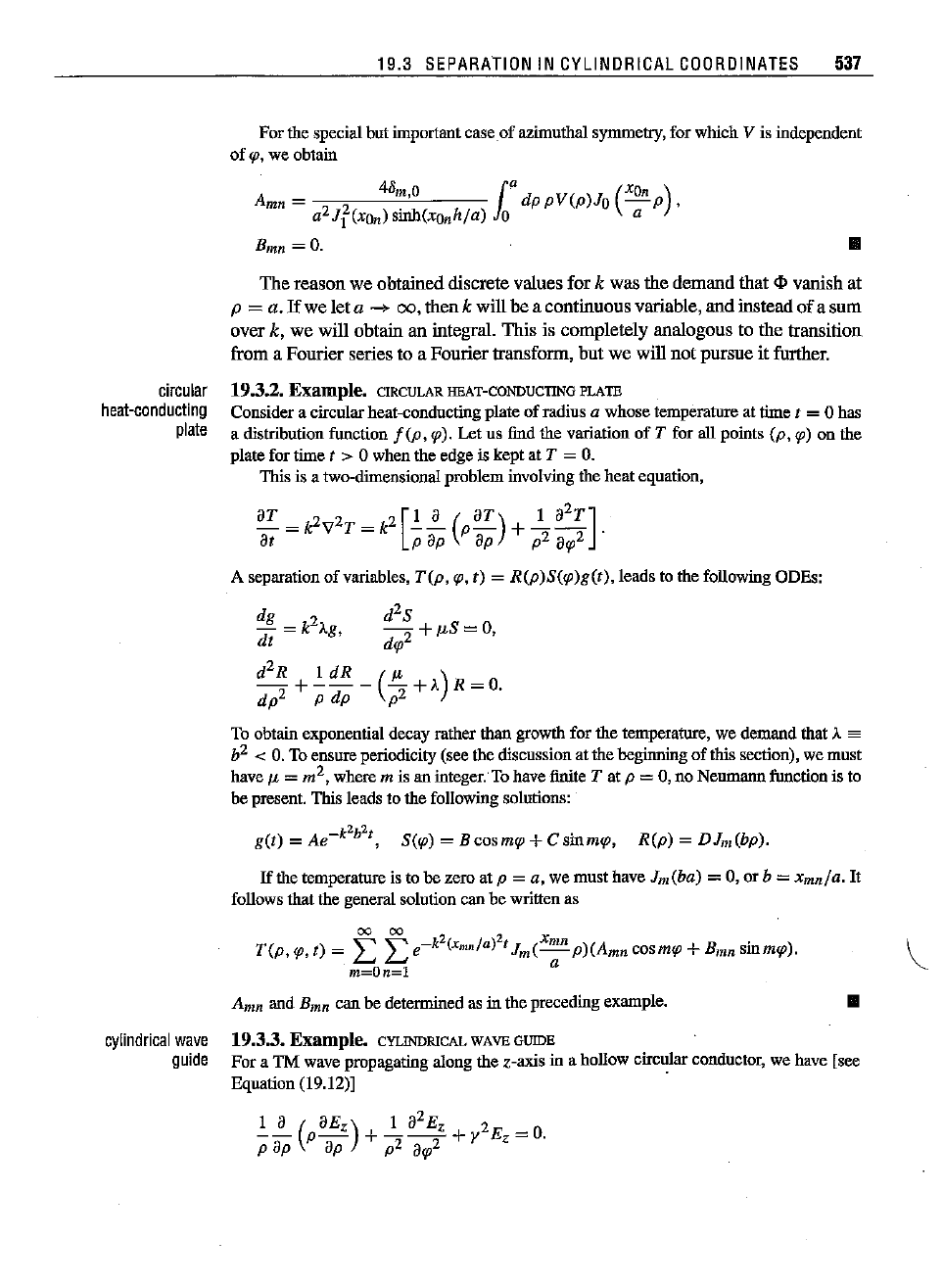
19.3
SEPARATION
IN CYLINDRICAL
COORDINATES
537
Forthespecialbut
important
case.of
azimuthal
symmetry,
forwhichV is
independent
of
sp,
we
obtain
40
m
0
In"
(x
on
)
A
mn
= '
dppV(p)Jo
-p
,
a
2Jf(xo
n)
sinh(xOnhja) 0 a
B
mn
=0.
..
circular
heat-conducting
plate
The
reason we obtained discrete values for k was the demand that
<I>
vanish at
p = a.
If
we let a
-+
00,
thenk willbe a continuous variable,
and
instead
of
a sum
over
k, we will obtain an integral. This is completely analogous to the transition
froma
Fourier
seriesto a
Fourier
transform,
butwe willnot
pursue
it
further.
19.3.2.
Example.
CIRCULAR
HEAT-CONDUCTING
PLATE
Consider
a
circular
heat-conducting plateof
radius
a whose
temperature
attimet =0 has
a disIribution function f
(p,
<p).
Let us findthe variation of T for alt points
(p,
<p)
on the
platefortimet > 0 whentheedgeis keptatT =
O.
Thisis atwo-dimensional
problem
involvingtheheat
equation,
aT = k
2V2T
= k
2
[.!.i.
(/T)
+ 2.a
2T].
at p ap Bp p2
B<p2
A separationof variables,
T(p,
<p,
t)
= R(p)S(<p)g(t), teadsto the following ODEs:
dg 2 d
2S
-d
=k
Ag,
-2
+tLS=O,
t
dsp
a
2R
t
dR
(tL
)
d
p2
+ Pdp - p2 +A R =
O.
To
obtain
exponential
decay
rather
than
growth
forthe
temperature,
we
demand
that
A
==
b
2
<
O.
Toensureperiodicity (see thediscussionatthebeginningof thissection),we must
have
f.L
=m
2
,
where
m is aninteger.'Tohave finite T at p =0, no
Neumann
function
is to
be
present.
Thisleadstothefollowing
solutions:
get) =
Ae-k'b",
S(<p)
= Bcosm<p +Csinm<p,
R(p)
=
DJm(bp).
If
the
temperature
is tobezeroatp =a, we musthaveJm(ba) = 0, orb = xmn/a. It
followsthatthe
general
solution canbe
written
as
00
00
T(p,
sp,
t) = L L
e-k2(Xmn/a)2t
Jm(x:
n
p){A
mn
cosm<p
+B
mn
sinm<p).
m=On=l
A
mn
and
Bmn
canbe
determined
asinthe
preceding
example.
..
cylindrical
wave
guide
19.3.3.
Example.
CYLINDRICAL
WAVEGUIDE
ForaTMwave
propagating
alongthez-axisin ahollow
circ~ar
conductor,
we have[see
Eqnation(19.12)]
1
B
(BE
Z ) t B
2E
z 2
--
p-
+---+y
Ez=O.
p Bp Bp p2
B<p2
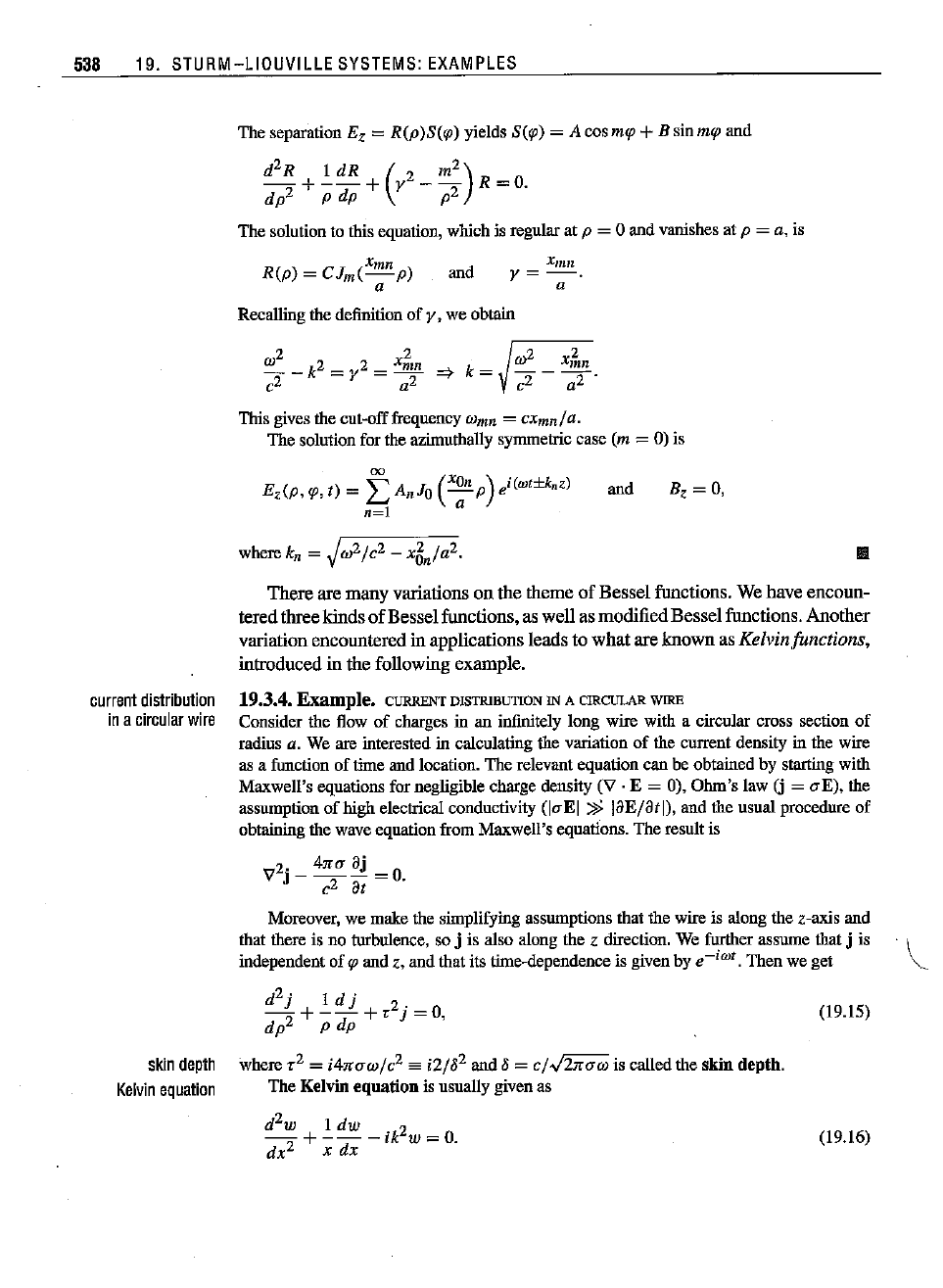
538 19. STURM-LIOUVILLE
SYSTEMS:
EXAMPLES
The separation E
z
=R(p)S(rp) yields S(rp) = A cosmrp +H sinmrpand
d
2R
I
dR
( m
2)
d
p2
+ Pdp + y2 - p2 R =
O.
The
solution
tothis
equation,
whichis
regular
at p = 0 and
vanishes
atp = a, is
R(p)
=
CJm(x
mn
p)
a
and
X
mn
y=-.
a
Recalling the
definition
of y, we
obtain
Hz
=0,
and
This gives the cut-offfrequency lVmll =
cXmn/a.
The
solution
forthe
azimuthally
symmetric
case(m = 0) is
Ez(p, v,t) =
f:
AnJO
(X~n
p)
ei(wt±knz)
n=l
11II
current
dlstrlbutlon
in
a
circular
wire
There
are
many
variations on
the
theme
of
Bessel
functions. We have encoun-
leredthree
kinds
of
Besselfunctions, as well as modified
Bessel
functions. Another
variationencountered in applications leads
10
whal
are
known
as
Kelvinfunctions,
introduced in
the
following example.
19.3.4.
Example.
CURRENT DISTRlBUTION IN A CIRCULAR WIRE
Consider
the flowof
charges
in an
infinitely
long wire witha
circular
cross
section
of
radius
Q.
We
are
interested
in
calculating
the
variation
of the
current
density
in the wire
as a
function
of time
and
location.
The
relevant
equation
canbe
obtained
by
starting
with
Maxwell's equations for negligible charge density
(V·
E = 0), Ohm's law G= ,,-E), the
assumption of
high
electrical conductivity
(I,,-EI
» jaE/atl), and the usual procedure of
obtaining
thewave
equation
fromMaxwell's
equations.
The
result
is
2. 4",,,-aj
V
J-7at
=0.
Moreover,
we
make
thesimplifying
assumptions
that
thewireis alongthez-axis
and
that
there
is no
turbulence,
so j is also alongthe z
direction.
We
further
assume
that
j is . t
independent
of
<p
and
z,and
that
its
time-dependence
is givenby
e-
iwt
.
Thenwe get "-.
skin
deplh
Kelvin
equation
d
2.
I d .
_J
+
_-.-1.
+<2j = 0,
d
p2
pdp
where <2= i4"',,-w/c
2
==
i2/~2
and
~
= c/-'/2",,,-w is called the skin depth.
TheKelvinequationis
usually
givenas
d
2w
I dw 2
--+---ik
w=O.
dx
2
x dx
(19.15)
(19.16)
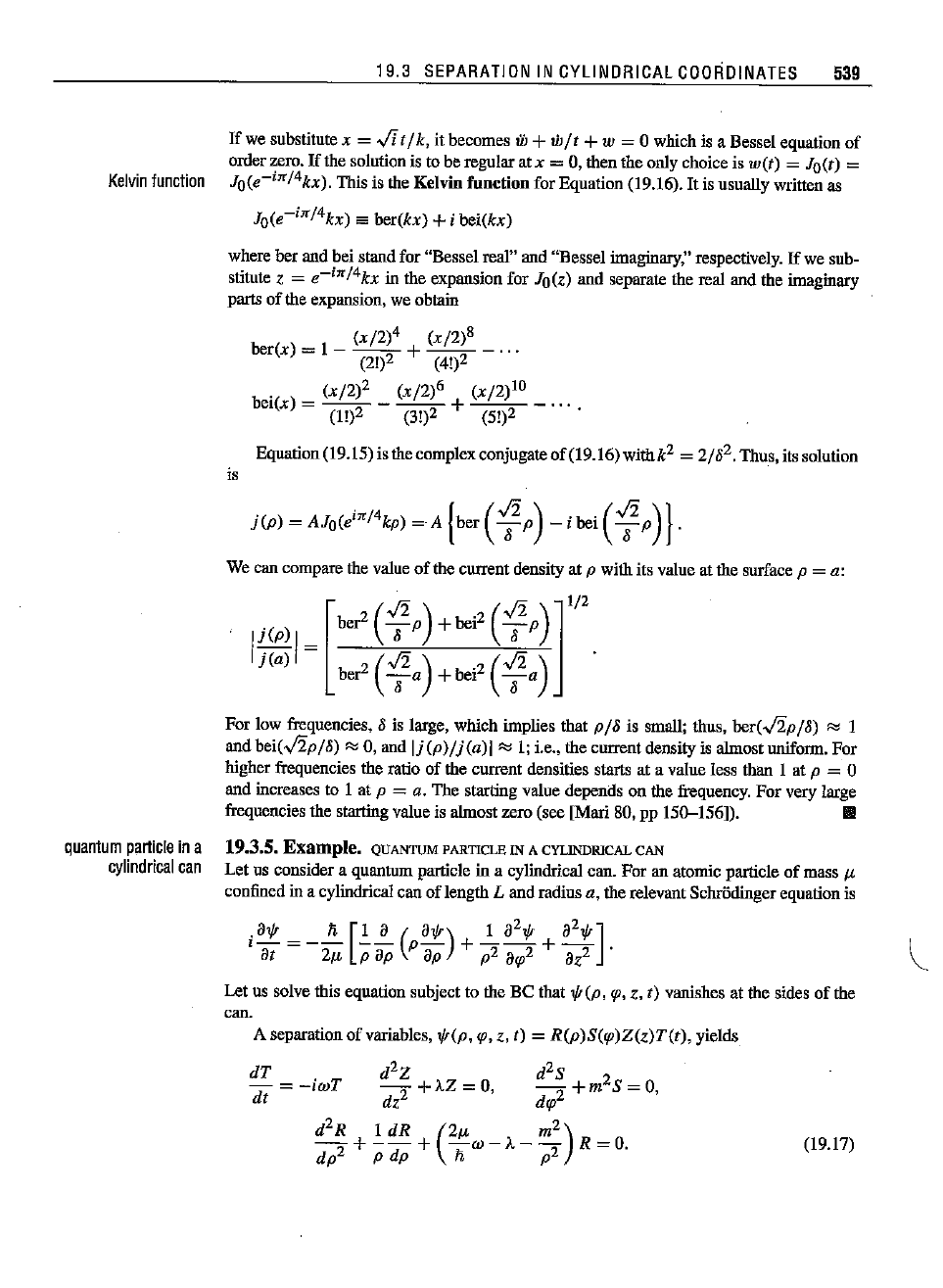
19.3
SEPARATION
IN CYLINDRICAL
COORDINATES
539
If
we
substitute
x = ,Jit/ k, itbecomesin+
tiJ
/ t + w = 0 whichis a Bessel
equation
of
order
zero.
If
the
solution
is tobe
regular
atx = 0, thentheonlychoiceis wet) = Jo(t) =
Kelvin
function
Jo(e-
i
-n
j
4kx).
This
is
the
Kelvinfunction for
Equation
(19.16).It isusually
written
as
Jo(e-
hr/
4kx)
es ber(kx) +i bei(kx)
where
ber
and
bei
stand
for"Bessel
real"
and
"Bessel
imaginary,"
respectively.
If
we
sub-
stitute
z =
e-
i
1C
j
4kx
in theexpansion for Io(z) and
separate
therealandthe
imaginary
parts
of the
expansion,
we
obtain
(xI2)4 (xI2)8
ber(x) =
1-
--+--
- ...
(2!)2 (4!)2
. (xI2)2 (xI2)6 (xI2)10
beifx) = (1!)2 - (3!)2 + (5!)2 _
....
Equation(19.15) is the complex conjugate
of(l9.16)
withk
2
=
2/13
2
.
Thus,its solution
is
j(p)
= AJo(ein/4kp)
=-A
{ber
(~
p)
-
ibei
(~
p)}.
Wecan
compare
the
value
of the
current
density
atp withits
value
atthe
surface
p = a:
[
(
~
)
(~
)]1/2
j(p)
ber
2
T
P
+bei
2
T
P
I
j(a)
I= b 2
(~)
b.
2
(~
)
er
-a
+ el
-a
13 13
quanlum
particle
ina
cylindrical
can
For low frequencies,
13
is large, which implies that P
113
is small; thus, ber(
~p
113)
'" I
and
bei(~pllJ)
'"
0, and
Ij(p)lj(a)1
'"
I; i.e., the current density is almost uniform. For
higher
frequencies
the
ratio
of the
current
densities
starts
at a valueless
than
1 at p = 0
and
increases
to 1 atp = a. The
starting
value
depends
on the
frequency.
Forvery
large
frequencies the starting value is almost zero (see [Mati 80, pp 150-156]). II
19.3.5. Example. QUANTUM PARTICLE IN A CYUNDRICAL CAN
Letus
consider
a
quantum
particle
in a
cylindrical
can.Foranatomic
particle
of mass
f.L
confined
ina
cylindrical
canof lengthL and
radius
a, the
relevant
Schriidinger
equation
is
.
at
Ii
[I
a (
at)
Ia
2t
a
2
t]
I at = -
2{Jo
Pap p ap + p2
arp2
+ az
2
.
Letus solve this
equation
subject
to the
Be
that1/!(p,qJ,Z, t)
vanishes
atthesides of the
can.
A separation of variables,
t(p,
rp,
z, t) =
R(p)S(rp)Z(z)T(t),
yields
dT
d
2Z
d
2S
-=-;OJT
-+AZ=O,
-+m
2
S = O,
dt dz
2
drp2
d
2
R +
.!:.
dR
+
(2{Jo
OJ
_ A _ m
2
) R
=
O.
(19.17)
dp2
pdp
Ii p2
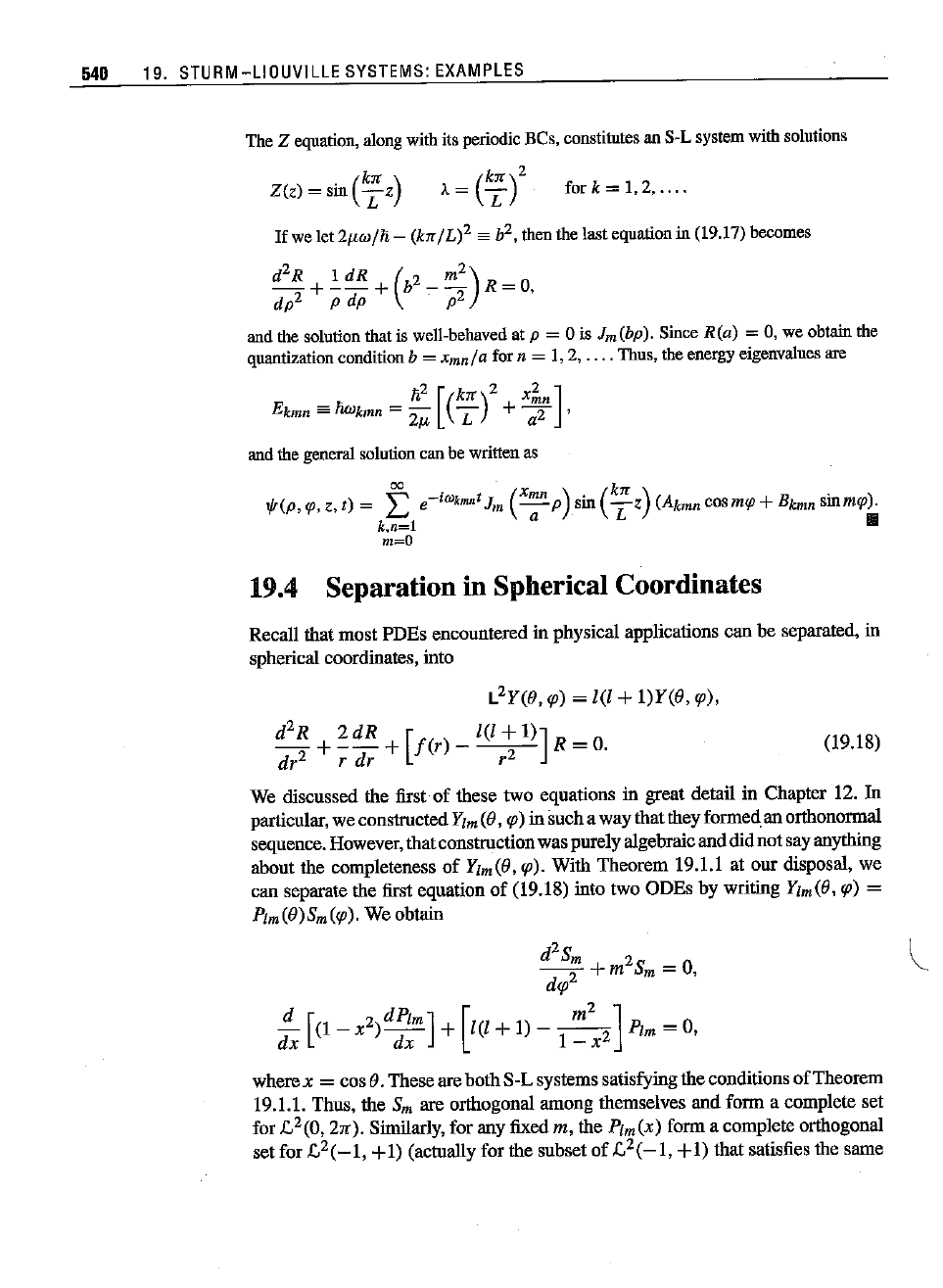
540 19. STURM-LIOUVILLE
SYSTEMS:
EXAMPLES
TheZ
equation,
along
withits
periodic
Bes,
constitutes
anS-Lsystemwith
solutions
Z(z)
= sin
(k;
z)
fork=I.2
.....
(19.18)
If
welet 2/Lw/1i-
(k:n:
/L)2 '" b
2•
thenthe lasteqnationin (19.17)becomes
d
2R
+.!:.dR
+(b
2_
m
2
) R = O.
d
p2
pdp
. p2
andthe solutionthatis well-behaved at p = 0 is Jm(bp). Since R(a) =
O.
we obtainthe
quantization
condition
b =
xmn/a
forn = 1,2,
....
Thus,
the
energy
eigenvalues
are
and
the
general
solution
canbe
written
as
~
-iw
t
(xmn).
(k:n:
) .
'!J(P.
<P.
z, t) =
L,
e km. J
m
-p
8m
-z
(Akmn
cce
mo
+
Ekmn
smm<p).
k,n=l a L III
m=O
19.4 Separationin Spherical Coordinates
Recall that
most
PDEs encountered in physical applications
can
be separated. in
spherical coordinates. into
L
2y(O.
<p)
=
1(1
+I)Y(O.
<p).
d
2R
+~dR
+[f(r)_I(I+I)]R=O.
dr
2
r
dr
r
2
We discussed the first
of
these two equations in great detail in Chapter 12. In
particular. we constructedYim(0.
<p)
in sucha way thatthey formedan orthonormal
sequence. However. thatconstructionwas purelyalgebraicand did not say anything
about the completeness
of
Ylm(O.
<pl.
With Theorem 19.1.1 at our disposal, we
can separate the first equation
of
(19.18) into two ODEs by writing Ylm(O.
<p)
=
Pl
m
(O)Sm
(<p).
We obtain
d
2S
m
2
--2
+m
Sm=O.
d<p
d [ 2
dPlm]
[ m
2
]
-
(l-x
)--
+
1(1+1)---
Plm=O.
dx dx
l-x
2
wherex = cos
O.
Theseare bothS-L systems satisfyingthe conditions
of
Theorem
19.1.1. Thus. the Sm are orthogonal among themselves and form a complete set
for ,(,2(0. 2IT).Similarly. for any fixed
m. the Plm(X) form a complete orthogonal
set for ,(,2(
-1.
+1) (actually for the subset
of
,(,2(
-1.
+1) that satisfies the same
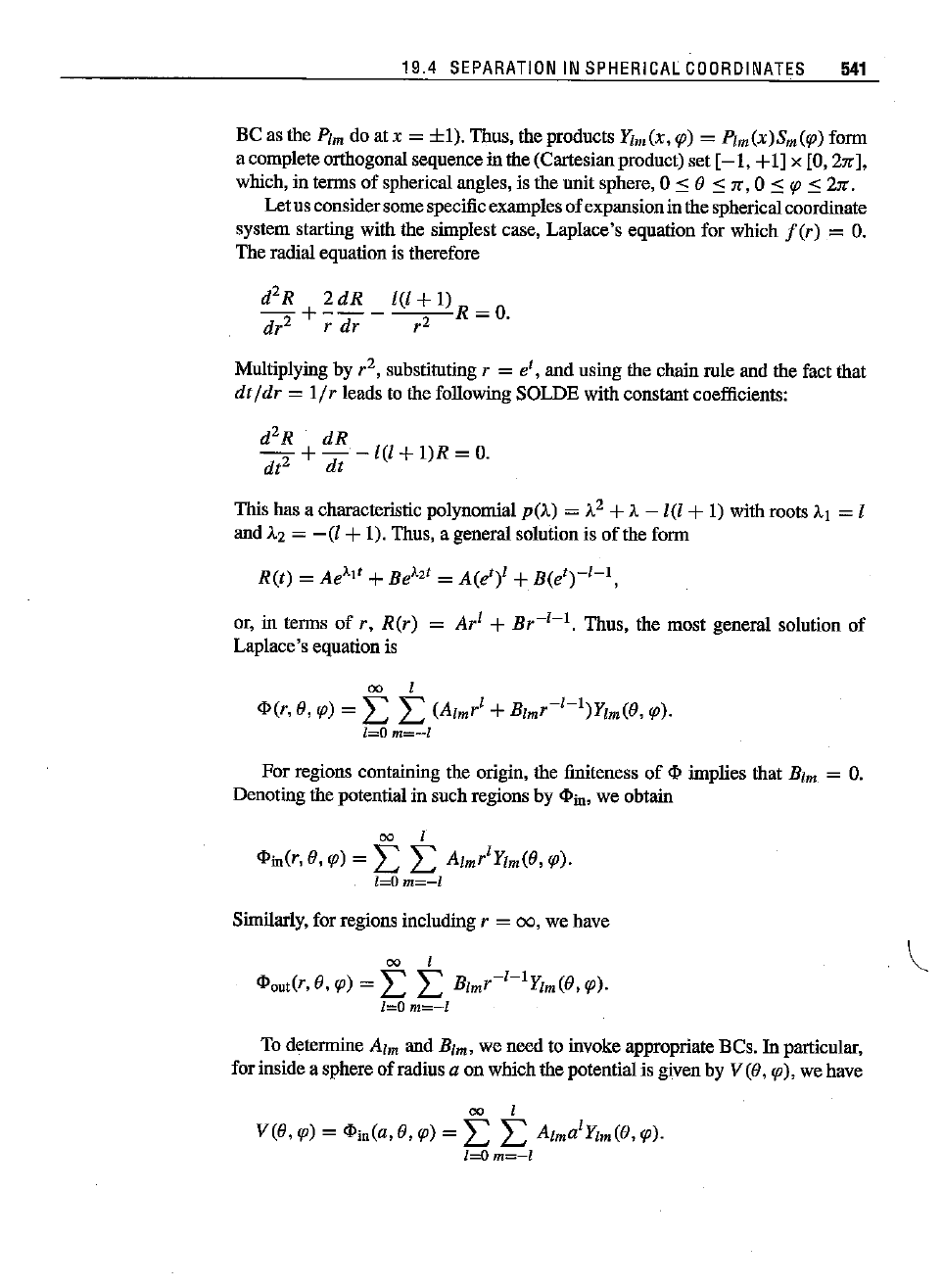
19.4
SEPARATION
IN
SPHERICAL
COORDINATES
541
BC as the Pi«do
atx
=
±I).
Thus, the products Ylm(X,
<p)
=
Plm(X)Sm(<P)
fonu
a complete orthogonal sequence in the (Cartesianprodnct) set
[-I,
+I] x [0,
2,,],
which, in tenus of spherical angles, is the unit sphere, 0
::::
e
::::
x ;0
::::
<p
::::
2".
Let ns considersome specific examples of expansionin the spherical coordinate
system starting with the simplest case, Laplace's equation for which
fer)
=
O.
The radial equation is therefore
d
2R
2dR
1(1
+
I)
-+---
R=O.
dr
2
r
dr
r
2
Multiplying by r
2
,
substituting r = e', and using the chain rule and the fact that
dt
[dr
=
I/r
leads to the following SOLDE with constant coefficients:
d
2R
dR
- +
-·-1(1
+
I)R
=
O.
dt
2
dt
This has a characteristic polynomial peA) = A
2
+A
-1(1
+I) with roots Al = I
and
A2
=
-(I
+
I).
Thus, a general solution is
of
the fonu
R(t)
= Ae
AI
'
+Be
A
"
=
A(e')l
+
B(e,)-I-I,
or, in tenus
of
r,
R(r)
=
Ar
1
+
Br-
I-
I.
Thus, the most general solution of
Laplace's equation is
00
1
<I>(r,
e,
<p)
= L L (Alm
rl
+Blmr-1-I)Ylm(e,
<p).
I=Om=-l
For regions containing the origin, the finiteness
of
<I>
implies that Blm =
O.
Denoting the potential in such regions by
<l>in,
we obtain
00
1
<l>in(r,
e.
<p)
= L L AlmrIYlm(e,
<p).
I=Om=-1
Similarly, for regious including r =
00,
we have
00
I
<l>out(r,
e,
<p)
= L L
Blmr-I-IYlm(e,
<p).
1=0
m=-l
To determine Aim and Blm, we need to invoke appropriate BCs. In particular,
forinside a sphere of radius
a on which the potential is given by Vee,
<p),
we have
00
1
vee,
<p)
=
<l>in(a,
e.
<p)
= L L Alma1Ylm(e,
<p).
l=Om=-1
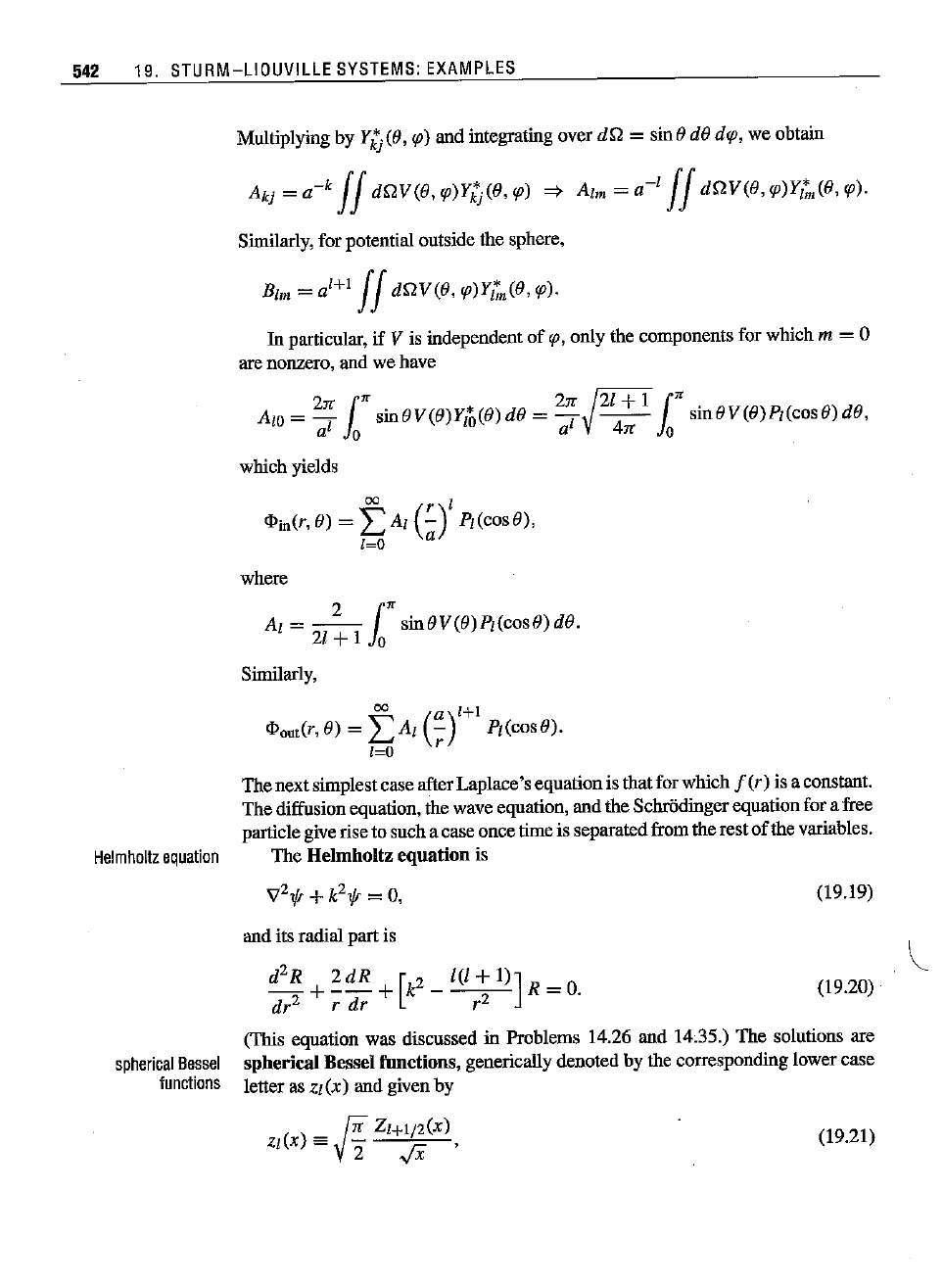
542
19. STURM-LIOUVILLE
SYSTEMS:
EXAMPLES
Multiplying by
Y~
(0,
91)
and integrating over dQ = sin 0
dO
d91,
we obtain
Akj
=
a-
k
II
dQV(O,
91}Y~(O,
91}
=}
Aim
=
a-I
II
dQV(O,
91}Y
I;"(O,
91}·
Similarly, for potential ontside the sphere,
Rim
= a
l
+
1
IIdQV(O,
91}Y
I;"(O,
91}·
In
particular, if V is independent of
91,
only the components for which m = 0
are
nonzero,
and
wehave
2rr
1"
2rr Fll-I+1
1"
.
Am=
-I
sinOV(O}Yio(O}dO=
-I
-4-
smOV(O}PI(cosO}
ae.
a 0 a tc 0
which yields
where
Al =
_2_
{"
sinOV(O}PI(COSO}
so.
21
+1
10
Similarly,
The next simplestcase after Laplace'sequationis that for which
f
(r)
is a constant.
The diffusion equation, the wave equation, and the Schriidingerequationfor a free
particle giverise to such a case once time is separatedfrom the rest
of
the variables.
Helmholtz
equation
The Helmholtz equationis
(19.19)
(19.20)
and its radial part is
d
2R
+~dR
+[k2_1(l+I}]R=0.
dr
2
r dr r
2
(This equation was discussed in Problems 14.26 and 14.35.) The solutions are
spherical
Bessel
spherical
Bessel functions, generically denoted by the corresponding lower case
functions
letter as ZI(X} and given by
(19.21)
